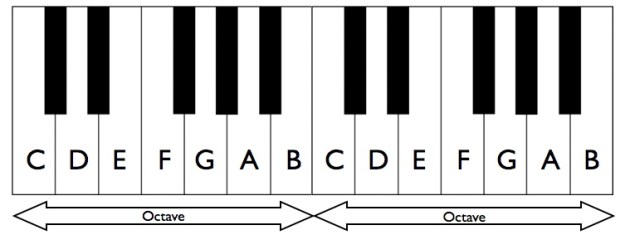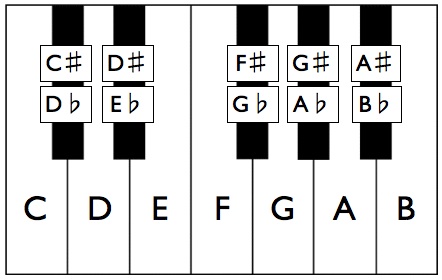In nature there are a lot of sounds. From the very low to the very high. In music we choose just some of those sounds to work with. The basic sound is called the note. The rest of this tutorial will explain notes.

- The piano keyboard is useful for helping to learn the notes
- There are a lot black and white keys on a piano
- Each key when pressed plays a particular note
- Moving left or right changes how low/high the note sounds
- The keyboard provides a large range of notes from low to high
- With so many notes how do figure out the names?

- There is a repeating pattern: Two black notes followed by three black notes
- The pattern repeats for the entire length of the keyboard
- The white key notes are named using the letters A to G
- Often the keyboard is drawn starting with C as above
- Each C to B “chunk” is referred to as an octave. There are two octaves in the keyboard above

- Each key plays a note that only shows up once on the keyboard
- …but notes with the same name sound the same but are higher or lower in pitch
- The C in the center of this keyboard will sound higher in pitch than the C on the left. It is one octave higher in pitch
- Different instruments have different octave ranges
- The black notes also have names
- The names are based on the notes around them
- Because each black note is surrounded by two white notes the black notes have more than one name
- The different names make more sense in different situations

- The symbol “#” is pronounced “sharp”. # means one “half step” higher
- A “half step” is the smallest distance between two notes. On a piano it means the distance between a key and the next (or previous) black or white key
- C# for example means “one half step higher than C”
- Notice that there are no black keys/notes between E – F and B – C

- The symbol “♭” is pronounced “flat”
- ♭ means one “half step” lower
- D♭ for example means “one half step lower than D”

- Above the black notes are labeled with both their names
- The first black key is C# but it is also D♭
- As mentioned usually one name makes more sense than another in a particular situation (more in future tutorials)
Summary
- There are 7 white notes named using letters A – G
- There are 5 black notes named based on the white notes around them. Either by using # or ♭
- All together there are 12 notes that form an octave
- The octaves repeat. Different instruments have different amounts of repetition. That is different octave ranges
Bonus: Accidentals

- These symbols are called accidentals. They modify notes
- We already learned about ♭ and ♯. There are a few more you should know about
- The and are the “double flat” and “double sharp” respectively. They are like sharps and flats but adjust the note up or down two half steps. They are more rare and used in special cases
- The ♮ is called the “natural”. It means cancel all other signs. The notes without sharps or flats are referred to as natural notes
Next: The Major Scale